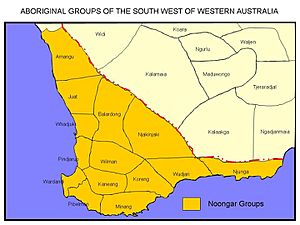Pindjarup facts for kids
The Bindjareb (also known as Binjareb, Pindjarup, or Pinjareb) are an Indigenous group of the Noongar people. They live in the South West part of Western Australia.
Contents
What's in a Name?
It's not fully clear if "Pindjarup" is the original name for this group. The word "pinjar" or "benjar" means "wetlands" or "swamps." This suggests the Pindjarup were known as the "people of the wetlands."
Where Did They Live?
The Pindjarup people lived in an area of about 1,800 square miles (4,662 square kilometers). This land included places like Pinjarra, Harvey, and the Leschenault Estuary. They also lived along the lower parts of the Murray River.
How They Lived
The Pindjarup were known as "people of the wetlands" because they were very skilled at using the resources around them. They were famous for their fish traps. They followed a cycle of six seasons, which helped them use all the different foods available. They gathered food from coastal areas, sand dunes, lakes, wetlands, and the fertile lands near the Darling Scarp hills.
Their diet included Western long-necked tortoises, black swans, ducks, and migratory birds.
Early European Settlement
Europeans first explored Pindjarup lands in 1829. Lieutenant P. N. Preston and Dr. Alexander Collie sailed the HMS Sulphur to explore the mouths of the Peel Inlet, the Serpentine and Murray Rivers, and the Leschenault Inlet.
In 1830, the Pindjarup killed a 19-year-old explorer named George MacKenzie. Two years later, after a soldier was hurt on the Murray River, Frederick Irwin sent a group to punish the Pindjarup. This group killed five Pindjarup people and injured several others.
Thomas Peel, a relative of the British Prime Minister Sir Robert Peel, was given a large area of land. Some of this land was Pindjarup territory. The Pindjarup also had disagreements with the Whadjuk people from the Swan River.
In December 1833, the Pindjarup's right to visit their relatives and perform ceremonies in the northern area was recognized at a corroboree (a traditional Aboriginal gathering). The Pindjarup then resumed their visits. The Whadjuk people had also faced many conflicts with white settlers who took land where their main food, yams, grew.
In February 1834, clashes happened between the Pindjarup and settlers. This was after Pindjarup dingoes (wild dogs) attacked livestock near Perth. During one standoff, the Pindjarup leader Calyute bravely held his spear against a soldier who had a musket pointed at Calyute's chest. The Whadjuk and Pindjarup disagreed on how to deal with the settlers, especially after a fight between Calyute and a Whadjuk man named Yaloo.
In April 1834, Calyute raided George Shenton's windmill. He tricked the owner and took a large amount of flour (444 kg). Whadjuk people told the settlers who was involved in the raid. Calyute and two other men, Yedong and Monang, were captured. Calyute was whipped 60 times in Perth's main street and then jailed for a year. He was released on June 10, 1834.
After Yedong was released, he set up an ambush on July 24. A private named Hugh Nesbit was killed, and a former soldier was wounded. Nesbit's death was blamed on a man named Noonar. The wounded man, though speared three times, managed to get to safety.
By September 1833, the military unit under Governor Stirling had more soldiers. Stirling also created a Mounted Police unit. On October 25, Stirling led troops, along with Peel, into Pindjarup lands. They wanted to get revenge for Nesbit's death and help Peel develop the land the Crown had given him.
The Pinjarra Massacre
What happened next is now known as the Pinjarra massacre. Stirling's group of 25 men found a Pindjarup camp with 70 to 80 people. They surrounded the camp, with some soldiers on each side of the river and others advancing. At least five Pindjarup people were shot dead right away. The rest tried to flee towards the river but were continuously fired upon.
One soldier was speared in the arm. Captain Ellis, the leader of the Mounted Police, was badly wounded and later died during the massacre. Stirling's official report said that 14 Pindjarup people were killed. However, modern estimates suggest that as many as 50 people died.
What Happened After 1834?
By 1836, a military settlement was built in Pinjarra. More land was given to settlers with little resistance from Aboriginal people. Many Aboriginal people started working in the pastoral industry (farming animals) that grew in the area. By 1838, a road connected Pinjarra to Bunbury through Pindjarup lands.
Pindjarup people survived the conflict, but their culture was affected by government policies. Leaders like Henry Prinsep and A. O. Neville tried to encourage intermarriage between Aboriginal people and white settlers. Outbreaks of diseases like measles also affected the population.
Despite these challenges, the number of Aboriginal people in Pindjarup lands has grown since the 1930s. Most now identify themselves as part of the larger Noongar language group, rather than specifically Pindjarup.
From the 1940s to the 1970s, up to 500 Aboriginal people, including many with Pindjarup heritage, were held at the Roelands Aboriginal Mission. Most of these people were taken from their families as part of the Stolen Generations policies of that time.
Other Names for the Pindjarup
- Pinjarra
- Penjarra
- Pidjain
- Peejine
- Murray tribe
- South West tribe
- Banyowla
- Bangoula
- Banyoula
- Kuriwongi (language name)
- Yaberoo ("northerners" applied to people around Wonnerup)
See Also
- List of massacres of Indigenous Australians
- List of Indigenous Australian group names


